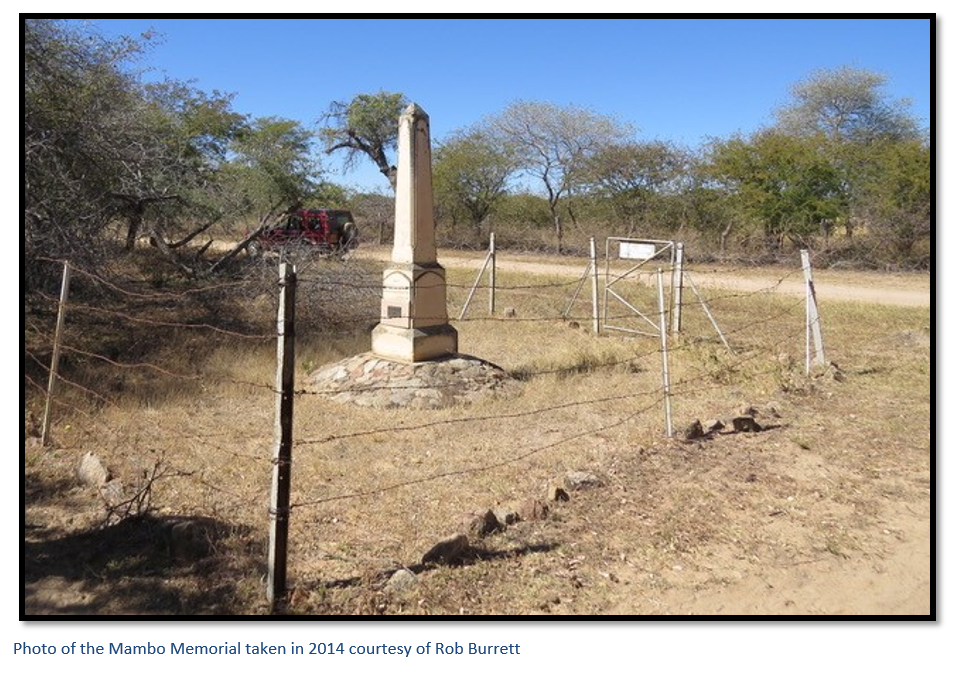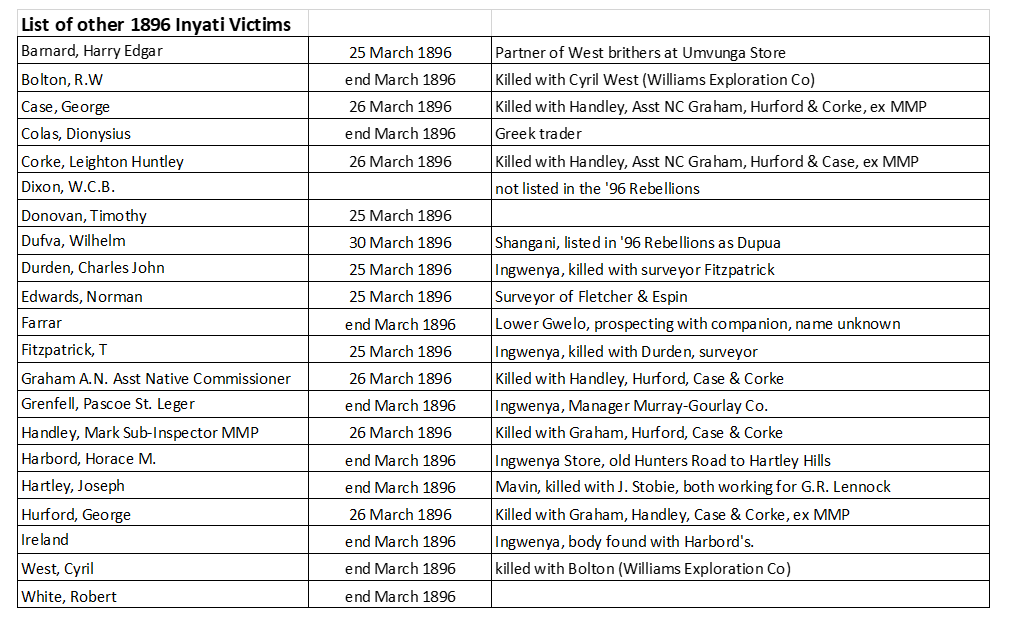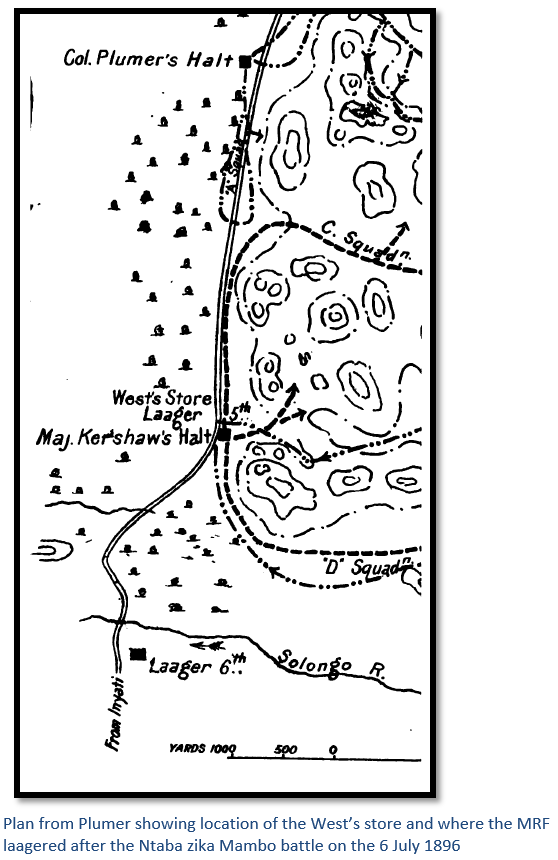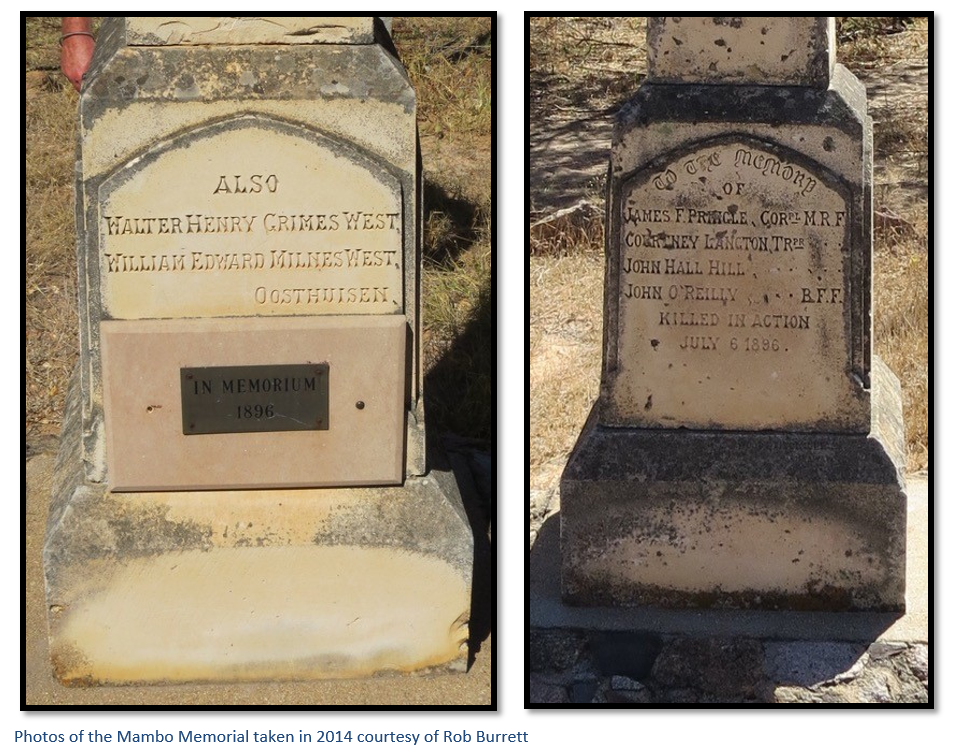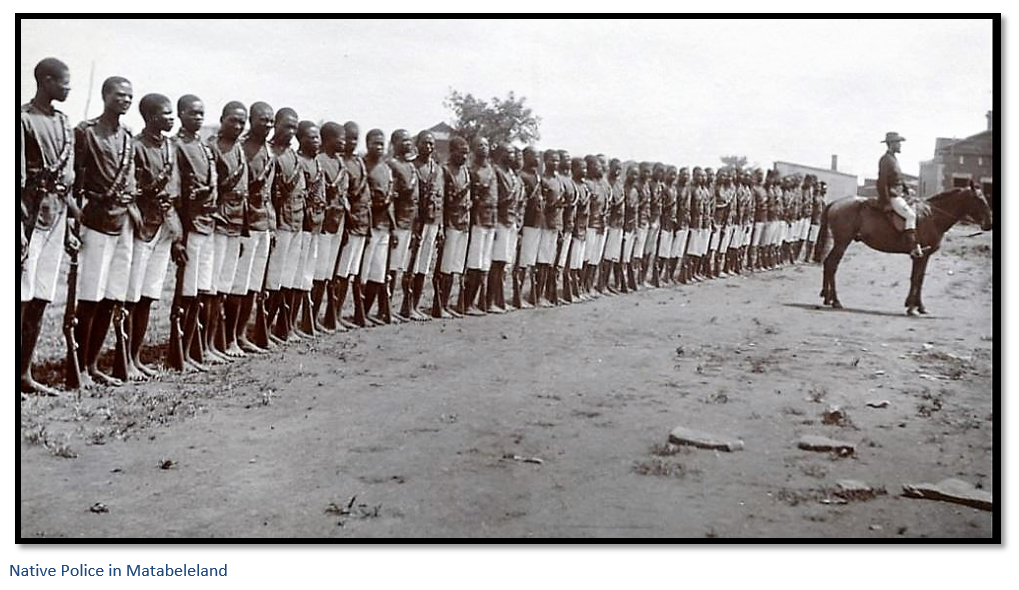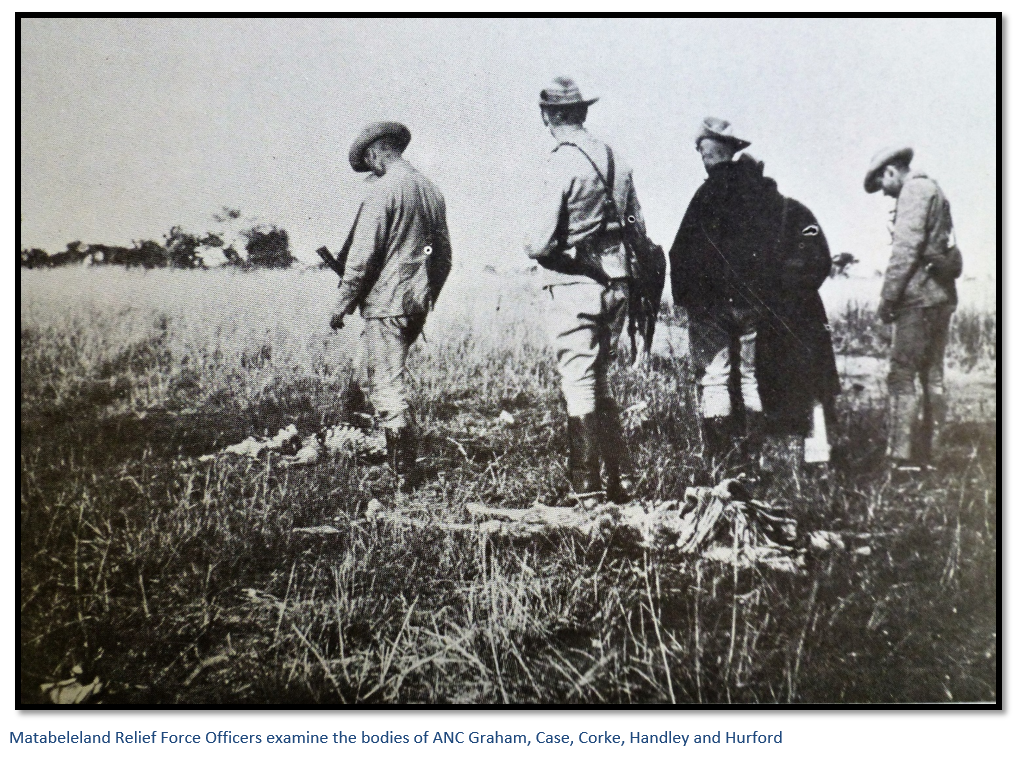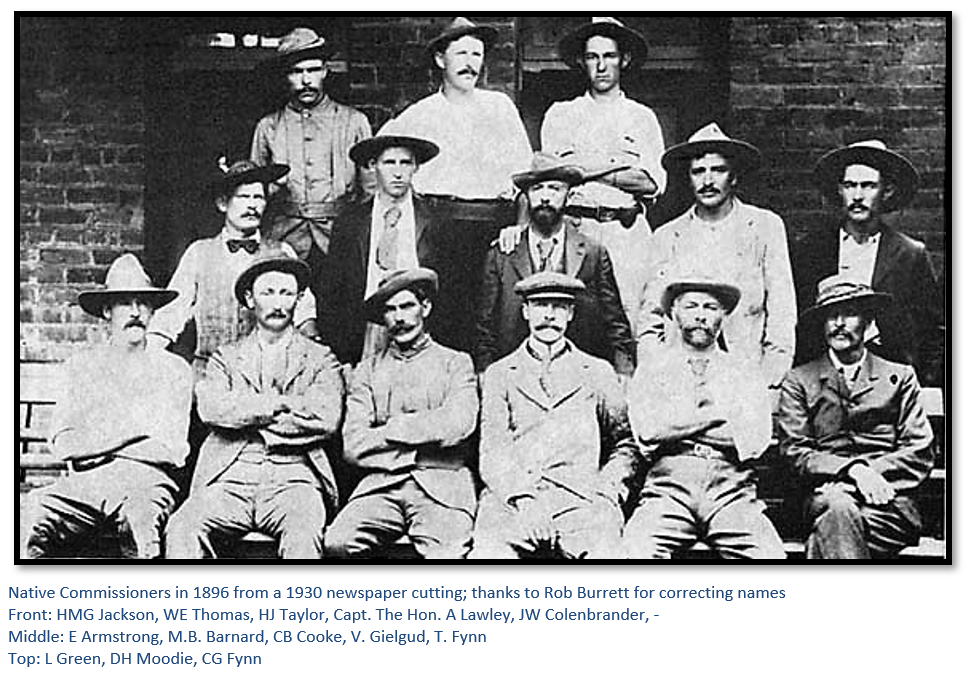Home >
Matabeleland North >
Mambo Rebellion Memorial – with three oral history accounts collected by Foster Windram in 1936 and 1938 concerning the killings at West’s store
Mambo Rebellion Memorial – with three oral history accounts collected by Foster Windram in 1936 and 1938 concerning the killings at West’s store
National Monument No.:
57
How to get here:
For directions to the area see the article on Manyanga (formerly Ntaba zika Mambo) Monument ruins.
I am advised by a prominent local historian that any potential visitors need to be VERY aware of local sensitivities when visiting the area which is a highly politicised place with competing groups fighting for control with even a visiting NMMZ inspection team being stoned by local people.
Note the Mambo Memorial was moved from its original site at West’s Store on the former Hunter’s road to its current site in the 1960’s when the new road was constructed. I have not personally visited the site to take an exact GPS location.
To reach West’s store, where the original Mambo Rebellion Memorial was situated, from the carpark site described under Manyanga Monument ruins, follow the track, formerly the old Hunter’s road, south-west along the line of hills immediately on your left for 4.8 KM until you almost reach the western end of the hills just before Vreis Farm. In the kopje to the east overlooking the store is where most of the victim’s property was found by Col. Plumer’s forces.
For the associated articles on the battle of Ntaba zika Mambo and the Manyanga Monument ruins and general directions to the area, see the website www.zimfieldguide.com
The four Matabele Rebellion, or Umvukela Memorials are all National Monuments; Pongo Memorial (No 33) near Shangani on the A5 Gweru – Bulawayo national road, Fort Rixon Memorial (No 58) at Claremont Mine, Filabusi Memorial (No 56) at the old hotel and store and the Mambo Memorial (No 57) originally at the site of West’s store on the old hunter’s road, but subsequently moved in the 1960’s when the road was re-aligned. All except the Filabusi memorial are all sited in the old Insiza district and are described on this website www.zimfieldguide.com The memorials followed the creation of a Rhodesia Memorial fund in 1896; meetings were held in Bulawayo and Salisbury (now Harare) with the aim of setting up memorials to those killed or wounded and for those that suffered financial loss and to erect hospitals, libraries and museums with many of the most prominent citizens on the committees. All four have Rhodesia Memorial Fund inscribed on their bases.
A number of other civilian victims were killed in the Inyati area and listed in the ’96 Rebellions:
Also killed in action at Ntaba zika Mambo were six members of Robertson’s Cape Volunteers; they are not commemorated, and their place of burial is not noted in the literature, but possibly they are where buried near Troopers Langton and O’Reilly in the vicinity of Robertson’s kopje.
The resident missionary in the turbulent times of 1893 and 1896 was Reverend Bowen Rees, isitsha senkosi, who served at Inyati Mission from 1888 to 1918 and was spared certain death because he had left Inyati Mission with his wife and children on the 26 March for Bulawayo; their two houses and the Church were all burnt down.
Selous reports in Sunshine and Storm in Rhodesia that ANC Graham and his companions Case, Corke, Handley and Hurford were found about a mile from the Inyati police camp on the road to Bulawayo with two servants; they had clearly put up a fight as eighty-five cartridge cases were picked up.
West brother’s store
Plumer writes that a skull was found near the laager where the MRF camped on the Longwe River on the night of 6 July 1896 after the battle of Ntaba zika Mambo, but no other traces of brothers William or Walter West, or their colleague Oosthuizen were uncovered. Their partner, Harry Edgar Barnard, was killed further east at another store where the old Hunter’s Road crossed the Vungu River. Both West brothers were former members of the Bechuanaland Border Police and had taken up farming and storekeeping on the old Hunter’s road. The brothers do not appear to be related to Cyril West whose name appears on the Pongo Memorial along with other casualties of the uprising. [See the article on the Pongo Memorial under Matabeleland South on the website www.zimfieldguide.com]
The importance of collecting Oral history
Contemporary accounts say they fought a splendid but hopeless, defence in their store at the southwest corner of the Mambo Hills and kept the amaNdebele at bay for ten long hours before being killed about 26 March 1896.
The 1936 Rhodesia Annual contained a request from the Rev. AJB West, the priest at St. Dunstan’s in the East, London, for information on the deaths of his relatives. In response Ivor Lane, the Asst. Native Commissioner at Que Que, sent a letter on 29 Oct 1938 containing the two statements quoted below from Tjugulu and Bobo to Foster Windram at the Bulawayo Chronicle office detailing the killing of the West Brothers.
These statements and the oral evidence collected by Foster Windram in 1936 – 1938 when as a reporter at the Bulawayo Chronicle he interviewed the only amaNdebele participant in the West killings who was not executed, Nganganyoni, confirmed that the West brothers were in fact, like most victims in Matabeleland, surprised and killed without resistance.
Tjugulu interviewed at Shangani Reserve on 13 October 1936 stated:
When the Mlimo (high priest or mouth piece of the Deity) sent out word from Ntabazamambo (hills of the King) that all the white people in the country were to be killed I proceeded with my regiment to Bulawayo. When I passed the white men’s store at the foot of the hills it was still standing, but there was no one about. I asked what had happened and was told that as soon as Mlimo’s word had been received by the native employees of the two white men, they murdered them. This is how it happened.
One of the natives employed as a store boy whose name was Tjontjelani (why does he steal) went to his hut and got his assegai which he hid under his coat and entered the store. He walked up to “Wani” the taller of the two brothers and drawing his assegai from under his coat, stabbed Wani in the chest killing him at once. The other brother, a well-built man with a beard, was also in the store and started forward to help his brother, but was caught around the waist by another native, an Mlozwi, employed to sew up grain bags, whose name I cannot remember. This native held Mandevu (beard) the shorter brother while Tjontjelani stabbed him in the chest. Death in the case of both brothers was instantaneous.
Tjontjelani and the Mlozwi then went out to the lands where the other white man, a farm assistant was working. These two and other natives working in the lands rushed on the white man and stabbed him to death.
All the natives then returned to the store which they looted; the stocks of which were chiefly printed limbo [cloth] and vests were taken to the Mlimo and handed over to him. The bodies were all left lying where they fell.
I went on towards Bulawayo with my regiment. At the Umgusa River near Bulawayo we were met by the white troops and in the battle that followed we were badly defeated and fled all the night. When we got back to Ntabazamambo the store was still standing and we passed it and hid in the hills. The Mlimo (a Mlozwi native called Mkwati) had already heard of our defeat and fled to the north. I heard he was afterwards captured and taken to Salisbury. I don’t know what happened to him there.
All this happened in the month when harvesting commenced (about May) [late March 1896] Several months later we left the hills and when we passed the store again we found it was burned to the ground. I don’t know who did this. I do not know what ultimately happened to the bodies of the three white men. All the murderers were subsequently caught and taken to Bulawayo where they were executed. [except Nganganyoni, whose statement is below]
The two storekeepers were popular amongst all natives. Whenever I passed the store a hut was prepared for me to sleep in. I was given blankets and food. I liked “Wani” especially, but I would have killed him had I not been forestalled. The Mlimo told us to kill all white men and I would have obeyed him.
The store stood a few hundred yards from the white monument [original site of the Mambo Rebellion Memorial] subsequently erected which I thought was where the storekeepers were murdered. I did not know it was erected to the memory of soldiers who had fallen in battle.
There was no shaft near the store. I am certain of this. I often visited the store. We bought with maize, pumpkins and wild squash – we had no money in those days. Mlimo betrayed us.
[ A note at the bottom states Tjugulu was a Zwangendaba Chief in Shangani Reserve]
Bobo interviewed at Shangani Reserve on 13 October 1936 stated:
I used to work for the West brothers Mandevu and Wani. When we heard that the cattle sickness (rinderpest) had broken out, Mandevu, Jimu and I went to Bulawayo for medicine for the cattle although the West brothers’ cattle had not yet become infected with the disease. We stayed a few days in Bulawayo and when we reached Inyati on our return to the store Mandevu fell ill (probably malaria fever) We tried to get on but Mandevu got much worse and so had to lie up. He sent me onto the store for the scotch cart to carry him as he could not walk. I got the cart as soon as I could and took Mandevu, who was then very ill, home. He went to bed in the hut which was beside Wani’s on the far side of the store from the mountains.
The West brothers had a Zulu native Jimu working for them. Jimu had married a Ndebele woman who had a child by her former husband. The day that Mandevu returned from Bulawayo this child died. Jimu did not know the Ndebele rites necessary for burial of the child, so sent me to the local headman who lived about a mile away to ask how the child should be buried. I did so, and the headman said “Tell Jimu to bring the child to me and I will bury her.” He also said that I was to tell the white men that their mealie crop was being destroyed by locusts. That evening Jimu took the child to the headman’s kraal. He did not return; he was murdered there. I knew nothing of this, nor did I know that a rising was imminent until next day.
Next morning I saw seven natives approaching the store. They came up to Wani who was with me at the wagon near the store and said that they wished to buy some goods. Wani went to the store with them, opened the door and entered, followed by Tjontjelani and the others. Then there came a cry of “Bulala amakiwa” (kill the white men) Mandevu came out of the hut where he was lying ill and Tjontjelani stabbed him in the chest with a short assegai and killed him. The seven natives then killed a “Holi” (Maholi) man and woman and two children. I don’t know their tribe. (NB Maholi is a term of contempt used by the Matabele to designate the members of any tribe which was not Ndebele) The murderers then came to kill me. I ran away but was captured and was about to be stabbed, but I was spared to gather and herd the white men’s cattle. The seven natives then went to the lands where the other white man was trying to save the crops from the locusts. I was told that they murdered him there.
When the seven men returned from the lands they dragged the white men’s bodies a little distance from the store. (Bobo indicates a spot a few paces to the right of the original site of the Mambo Rebellion Memorial) They then entered the store which they were looting when the headman who had murdered the Zulu [Jimu] came up. He accused Tjontjelani of having stolen a singlet (vest) Tjontjelani denied the theft but the headman was very angry and had him tied up to the wagon by a riem (hide thong) round his neck. When all the white men’s goods had been gathered up they were made into bundles to be taken to the Mlimo. Before the goods were taken away, Tjontjelani had his ankle tied to his thigh. He was then given a bundle and told to follow the others who were leaving for the mountains. He could not hop fast enough on one leg, so he was thrashed to death with sjamboks after his eyes had been beaten out. [not correct, Tjontjelani was charged with murder at Bulawayo and after being found guilty at his trial was hanged]
The white soldiers who came some months afterwards found the bodies of Mandevu and Wani [There is no evidence of this] They laagered their wagons right round the spot where they were. The bodies were not mutilated in any way. The only wounds they received were the ones that killed them.
After the surrender of the Matabele, the murderers of the West brothers were taken to Bulawayo. Five were convicted and hanged. Nganganyoni, the other, was acquitted and released – I don’t know why. He is an old man now and lives in the Fort Rixon district.
Statement of Nganganyoni, made to R. Foster Windram, at his kraal near Kombo siding on 20 November 1938. Interpreter: Peter Kumalo.
Note by interviewer: The statement was only obtained from Nganganyoni after the interpreter and myself had pledged our faith to him that it would never be shown to anyone who might be likely to do him any harm whatsoever as a result. We explained to him that the events concerned were now finished and forgotten and done with and that our interest in them was purely historical. If therefore this statement should come to the notice of any other white man I must rely on him to keep faith. RFW
The cause of the rebellion was labour recruiting – isibalwa. When the white people started the place which they call Selukwe the police used to come to our kraals – the Amagqokani we called the police then, because they had clothes on and a bandolier, and when they recruited us they used to beat us. They were our own sons and they beat us. That was the cause of the rebellion. When we were recruited we were taken to Selukwe. At that time I had my kraal at Inyati.
Another reason for the rebellion was they left no one at the kraal. They took everybody – that is all the males. If you had a goat at your kraal they would kill it and make you cook it for them. When the news spread all over the land that we were being badly treated everybody who was working in the mines returned to his kraal. The first place where we started to fight was at Inyati. I can’t remember who started it, it simply happened.
(In reply to a question about the Mlimo) Yes, you are right, because the news did come from the direction of the Matopos and the Mlimo said you had better fight because you are badly treated, and I will help you.
There was a man at Inyati who was a Native Commissioner there, by name Mehlweindugu (knobkerrie eyes) [This is ANC Graham] There was a police camp there. He was the man who was troubling us, and we started with him first. He is the man who used to beat us, and we killed him first. We met him early in the morning as he was leaving his place to run away. He had heard that there was going to be trouble because he had heard of the killing of the three white men at the store; Mandevu, Wani and Mandisi. Those three people were killed, and he heard about it and ran away. He heard the news at night and he got as far as the Bembesi River having left Inyati early in the morning by scotch cart and mules. Some waited for him at the Bembesi and some went to Inyati to see if he was there. I was with those that went to Inyati. We found he had left, and when we got back to the Bembesi we found the others had killed him. They shot him. They first shot the mules and then they shot him. They caught him unawares. He only knew of those in pursuit behind. He did not know that there were some waiting for him in front.
Mandevu, Wani and Mandisi were killed early in the morning three days before this. My kraal at Inyati was far away from the store. We left early in the morning and we arrived at about 9 o’clock. We were only six of us when we killed those people. We left our kraal to kill them. There was Tjontjelani, [sometimes called Tjontjonlani] myself, Mkumbi, Kafuli, Matekenya and Ngonye.
We divided off in groups to go off and kill the white people that we knew. Our kraal was separate, and we decided to go off and kill those white people. No one came around to tell us that the fighting had started. We had the news from the Matopos that Mlimo was going to help us, so we just decided amongst ourselves that there were white people over there and we had better go there. We had no grievance against these people. We killed them merely because they were white people. We were going to kill all the white people because we had the news that the Mlimo was going to help us.
These white people had a store built of brick with a thatched roof. The store was this side and the dwelling huts, which were just like our huts, were on the other side. The three white men lived in the three huts and all three had native wives.
I think it was about this time (9am) that we arrived at the store, six of us. We had knobkerries and axes. We did not show them that we were coming to fight. We found Mandevu in his hut, Wani was in the store and Mandisi was in the lands reaping mealies. (Questioned) No, he was not killing locusts, he was reaping mealies. We divided up. Some of us went to Mandevu and some of us went into the store. Mandevu was ill, he was lying in bed. I didn’t go there, I went into the store. Tjontjelani went to Mandevu with Mkumbi and Ngonye.
When we got to the store we asked for limbo. We told Wani that we wanted to buy limbo. We were waiting to hear those people who had gone to Mandevu because we had arranged that as soon as they started on that side we would start on this side. While we were still talking to Wani and he was looking at the limbo hanging up and pointing to different pieces and asking us which piece we wanted we heard a noise of something hitting boxes. (He makes a sound as of a rapid succession of dull thuds) we caught hold of Wani. I caught hold of Wani and we both fell down, and while we were on the floor Kafuli struck him with an axe behind the head as we were struggling on the floor. The one blow killed him.
Then when we were finalised with him those who had killed Mandevu came into the store and then we left the store together and went to the lands to look for the other one. [Mandisi] We divided up again. Two went for Mandisi – Matekenya and Ngonye, and four of us stayed at the store. The white men had three guns. I was able to shoot with a gun, so they said I had better take one gun and stay there in case anybody else came along.
When Matekenya and Ngonye reached Mandisi he did not know they were coming to kill him, because he knew them. They told us they hit him with a knobkerrie. When they got to him, he greeted them and told them as they had come, they had better help him with the reaping. They walked near him and then they hit him with a knobkerrie. Matekenya hit him, they hit him once and Ngonye then chopped his neck with an axe.
We heard from the others that they found Mandevu lying on his bed. He was very, very ill; he did not get up. These white people were our friends, and so they did not expect that we were coming to kill them. They were our friends, but since we were starting to fight they might have killed us too. It is also true that we had decided to get rid of all the white men in the country.
They did not hit Mandevu with a knobkerrie. Tjontjelani stabbed him with an assegai as he lay in bed. They only stabbed him once because he was sick, and he died at once.
We did not touch anything in the store, because we had been told that we were not to touch anything belonging to the white people. We were told that the Mlimo would come and take them. There was a man who was delivering the message. His name was Mkwati and he came around collecting all these things. He had others with to carry them. Mkwati was the messenger of the Mlimo. Mkwati’s kraal was really at Gobabambeni. When the white people came he ran away and stayed Ntaba zika Mambo. He was the man who went around giving the message to the people.
When we killed the three white people it took some time and Mkwati came and stayed at the store and told us all to bring everything there. If we killed any white man we had to bring the things to him. He was just like a Nkosi. [Nkosi is a respectful term of address to a master or chief] He was not a Nkosi, but we took him as a Nkosi because he was sent by the Mlimo. The store was just near the hills Ntaba zika Mambo and Mkwati lived on the hill.
We did not remove anything from the store. Mkwati did not touch it either. He just told them that they were to bring anything else to that store. We killed some people in the Insiza district the same day and we brought the wagons to that store and the horses too [Fitzpatrick, Durden, Grenfell, Harbord and Barnard – whose possessions were found in Mkwati’s cave after the Battle of Ntaba zika Mambo on 5 July 1896] The things remained in the store all the time we were fighting until the white people came. I cannot tell whether the things were taken by the white people, or by the Matabele. Some people came and lived on the hill near Mkwati and they were told that they were not to touch the things in the store and the store remained untouched until the white people came and then it was destroyed. When the white people came they burned all the kraals. I don’t know whether the white people looted the store when they came or whether it was looted by the Matabele before they came. There were many kraals there. I think the stuff stayed in the store about a month that I know of. The people could not touch anything because Mkwati’s orders were that anybody who was found in there was to be killed. Mvimbi and Mzogo were two men who were found in the store and killed by Mkwati’s order. We left the store untouched when we left, we were afraid to touch anything.
Tjontjelani was killed by the white people when he was convicted for his part in this affair. The reason that I got off was that there were three native women – the wives of the three white men; the people I was with killed one – the one belonging to Mandisi and when they wanted to kill the other two. I refused; I said: “why should we kill the women?”
Then I took those two women and kept them in my kraal. Then, as the fighting continued, I ran away with these two women when the white people advanced and afterwards when the impi was finished I took those two women to report that they were the women of the white people we killed. At that time we had no food. I took the women to Inyati because I was afraid that if the white people knew I had them with me they would kill me. So I took them to Inyati and left them there and ran away. I did not run very far. I went a little distance and sat down to watch what was going to happen to those women.
Then the police were sent to look for me. I ran away and went back to my kraal at Ntaba zika Mambo where I had left my wives. I had two at the time. I did not go back to Inyati and the police could not find me. I think it was about two years afterwards that I was arrested. We had reaped twice when we were all arrested. The other five were killed, they were hanged in Bulawayo. The reason I was let off was because of those two women I helped.
The statement of Bobo concerning Tjontjelani is read over to Nganganyoni and he replies that it is untrue. When I was arrested afterwards I found Tjontjelani in gaol. We were in gaol together. It was Mvimbi that was killed; Mvimbi and Mzogo. They were the people that were killed for taking things from the store. It was some time after the killing of the white men that this took place. All that time the things remained alone in the store. Nobody was on guard over them, but people were living all around. When the fighting started all the people moved their kraals to this part. Mvimbi and Mzogo were arrested by Mkwati and tied up. They were asked where they had put the things they had taken from the store and they denied the theft. Afterwards the things were discovered in their places – we were living in the hills at the time and they had no huts. Then they were ordered to be killed. According to our custom a man was not killed with an assegai for theft. The theft was ntakati – it was a bad thing. They were killed with knobkerries.
Mkwati was of the Mleya tribe of the Zambesi. He came to this country in the time of Lobengula and he lived at Babambeni near the Gokwe River. Afterwards, when the white people were in the country he went to the Matopos and brought back the message from the Mlimo.
When the white people came to Ntaba zika Mambo, where Mkwati was staying, he ran away and went to Salisbury. He went to the part of the Salisbury district that the Matabele call Matshiyamgombe [Chief Mashayamombe on the Umfuli River] and there he stirred up the Mashonas. Then the white people destroyed the Mashonas and Mkwati went to the place called Umvukwes and again he stirred up the people, Mashonas only and the Mashonas killed him. The reason why they killed him was that they had already had the news that he was causing trouble and when he came there the indunas ordered the people to kill him. The white people then said they should not have killed him because they wanted to see him. He is the man who organised the rebellion. He was the man who caused the whole trouble and he died at Umvukwes. They killed him in a curious way. They cut him up into pieces while he was alive with axes. They said if he was the man who was sent by the Mlimo they had better make sure he could not come to life again and make more trouble.
Mkwati used to stay at Babambeni. It was only after the white people came that he went to the Matopos. But even before the white people came he used to go to Njelele [the most well-known rain making shrine in the Matobo] with a woman – a tall women with a light complexion. Her name was Tenkela and he told the people that she was the Inkosikazi [wife] of the Mlimo. Tenkela stayed with Mkwati all the time until he was killed at Umvukwes. Tenkela was arrested and brought to Inyati, but they did nothing to her. They took her to Magola, a chief in the district and he was told to keep her, I think she is dead.
Mkwati brought Tenkela out just before the Rebellion. I don’t know where she came from, but Mkwati said he brought her from Njelele. There were always people in charge of Njelele, even now their descendants are still there. There was a man who was in charge; Mkwati was only a visitor. Mkwati was not a priest of Mlimo, he was an iwosana; he used to visit there, he only brought a message.
The iwosana were rain bringers, they used to come in a group and say they were sent by the Mlimo to make rain. They would dance at the kraal and the people would give them presents. They would choose a spot some distance from the kraal and announce that they were going to dance, and the people would bring them presents. In the time of Lobengula they were not allowed to go around the kraals and dance. Lobengula used to send a few men to Njelele with black oxen and they would find iwosana there and the iwosana would dance to make rain.
When the white men came to the country then the iwosana started to go from kraal to kraal. During the time Mkwati stationed himself at Ntaba zika Mambo he lived in a cave just near by the store, but up the hill.
(Questioned) Yes, there was a man at the store, a Zulu servant, but we killed him first before we got to the store. I forget his name. [Jimu] That Zulu native was staying at Umzungu’s kraal, with his wife, because Umzungu was his friend. We went to the kraal and we killed him at the kraal. Umzungu could not protect him, because he would have been killed too. We killed him because he was as good as a white man. Umzungu’s kraal was only a few hundred yards from the store and we killed the Zulu there before we got to the store. We did not kill any other people there.
Conclusions to be drawn from the above witness statements
- Nganganyoni’s statement to Foster Windram appears the most reliable. He was the only remaining amaNdebele participant in the West’s killings and forty-two years after the event had little reason to distort his knowledge of events. Tjugulu, the Zwangendaba Chief, was a witness after the event and mistakenly states Tjontjelani was a servant of the West brothers. Bobo was actually one of the West’s servants and his statement appears creditable. However, he confuses Tjontjelani, with that of Mvimbi and Mzogo, local amaNdebele, who were killed on the orders of Mkwati for stealing goods from the West’s store.
- All three statements give the moral justification for the killing of the white people as coming from the Mlimo through his messenger Mkwati at Ntaba zika Mambo.
- All three statements agree the West brothers were taken by surprise and were on friendly terms with the local amaNdebele. The ten-hour battle at the West’s store has no basis in fact.
- All three agree that the contents of the West’s store, and property from the other killings at Ingwenya, were taken to Mkwati’s cave close to the West’s store.
- Only Nganganyoni gives a reason for the outbreak of the Matabele rebellion, or Umvukela, which he attributes to forced labour recruiting. Local AmaNdebele people had been generally reluctant to enter the labour market. In Mozambique the Portuguese had established a system of forced labour called chibaro in 1899; a system that continued until the early 1960’s which decreed that all Africans of the Portuguese provinces were subject to a legal obligation to work on private estates and public enterprises. If they did not comply, the public authorities, the sipai (police) could force them to do so. In Matabeleland also, the native Commissioners sometimes used harsh methods through the native police in enforcing labour recruitment for the mines in Matabeleland. Assistant Native Commissioner Graham at Inyati is mentioned specifically.
- Nganganyoni states that the West brothers and Oosthuizen were killed three days before ANC Graham was killed at the Bembesi River on 26 March, making their deaths on 23 March 1896, amongst the earliest.
Thanks
Alan Windram, the son of Foster Windram, kindly loaned me the statements in his possession; copies are available in the National Archives of Zimbabwe. Rob Burrett and Rodney Tourle made useful corrections to my earlier drafts and provided photographs and helpfully marked locations as I have not yet visited the battle site and Mambo Hills.
Acknowledgements
O. Ransford. Bulawayo: Historic battleground of Rhodesia. A.A. Balkema Cape Town 1968
H.C.O. Plumer. An irregular Corps in Matabeleland. Kegan Paul, Trench, Trübner & Co. Ltd, 1897
The ’96 Rebellions; BSAP reports. Books of Rhodesia, Bulawayo 1975
F.C. Selous. Sunshine and Storm in Rhodesia, Books of Rhodesia. Bulawayo 1968
When to visit:
Be VERY aware of local cultural sensitivity
Fee:
not applicable
Category:
Province:

